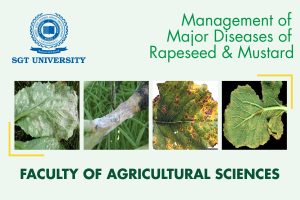Sustainable agriculture is undoubtedly a boon for our farming systems but in contrast, it also led to an increment in the production of “greenhouse gases,” thereby rising earth temperature, and causing ecological instability. As a result, multiple stress factors have been initiated by intensive agricultural practices, leading to imbalance the overall productivity of both agricultural systems and natural ecosystems. Owing to such critical responses, multiple stress factors such as pest resurgence, drought, nutrient deficiency, metal toxicity, salinity and soil erosion has been created. Further, the use of agrochemicals to beat biotic stress and supplement insufficiencies quickens natural destruction and may compromise human wellbeing. In a nutshell, the above-mentioned environmental pressure led to farming efficiency, soil disintegration, water deficit, biodiversity losses etc.
In the current situation, farming practices need to actualize a manageable way to deal with do ecological and financial advancements with the last point of keeping up yield while saving the biosphere. Reasonable improvement is the result of the communication of three elementary parts: climate, society, and economy. Different structures and systems of PGPR are broadly saddled to acquire farming attributes. Any component that enhances plant development either by providing promoters or by or growth regulators is depicted as an immediate tool. Notwithstanding, any tool that shields the plant from procuring diseases (biotic pressure) or assist the plant with developing steadily under natural burdens (abiotic stress) are viewed as an oblique component.
Plants are usually exposed to varied biotic stresses; and thus, have developed various defence strategies against plant pathogens. Apart from creating physical and chemical barriers, plants usually detect pathogen attacks and activate defence signalling networks, leading to induced defences that confer resistance. Plant growth-promoting rhizobacteria (PGPR) acts as a powerful counterpart and produces allelochemicals that include antibiotics, siderophores, organic compounds, and enzymes that elicit plant defence. Several PGPR including Pseudomonas, Bacillus, Arthrobacter, Serratia and Stenotrophomonas are known to produce volatile organic compounds (VOCs) having significant plant growth promotion. Few bacteria, viz., Bacillus and Pseudomonas sp., are widely known to depress fungal growth both in vitro and in vivo by secreting a wide range of lytic enzymes such as cellulases, chitinases, glucanases and proteases etc.
In addition to biotic stress mitigation, abiotic stresses such as drought, salinity and metal toxicity are major hindrances that limit plant productivity and directly or indirectly influence global food production. It has been estimated that approximately 70% of freshwater available on earth is used in the irrigation process. In the natural ecosystem, warm and dry spells often produce saline soils lowering agricultural productivity.
To mitigate such abiotic challenges, continuous researches are being carried out to develop advanced biotechnologically techniques to impart resistance in plants against such stress condition. In this regard, PGPR as plant and soil inoculants are frequently been used to cope with biotic and abiotic stresses from the last two decades. These microbes colonize the rhizosphere and elicit physical or chemical changes related to plant defence or stress tolerance. Under stress conditions, plant growth attributes like germination rate, drought tolerance, and root and shoot development are being maintained by these beneficial microbes. Previously, also many researchers have published reports on PGPR as elicitors of abiotic stresses, such as drought, salt and nutrient deficiency through a well-known plant growth-enhancing mechanisms such as siderophore production, hormone production, nitrogen fixation and phosphate solubilization. Microbe based phytoremediation can be categorized into phytoextraction (removal of toxic metal accumulation into plant cells), phytostabilization (reduced metal mobility by alteration of oxidation level), phytovolatilization (generation of volatile metal forms), and hemofiltration (metal precipitation, immobilization, and stabilization in rhizosphere). Heavy-metal-resistant bacteria residing in the rhizosphere may play a prime role in metal tolerance and accumulation in plants.
Owing to the multifarous role of PGPR in relieving both biotic and abiotic stress, it very well may be all around expressed that in not so distant future it will doubtlessly turn into a reality and be instrumental in significant cycles that guarantee the stability and profitability of agroecosystems, hence driving us toward an ideal agricultural system.



